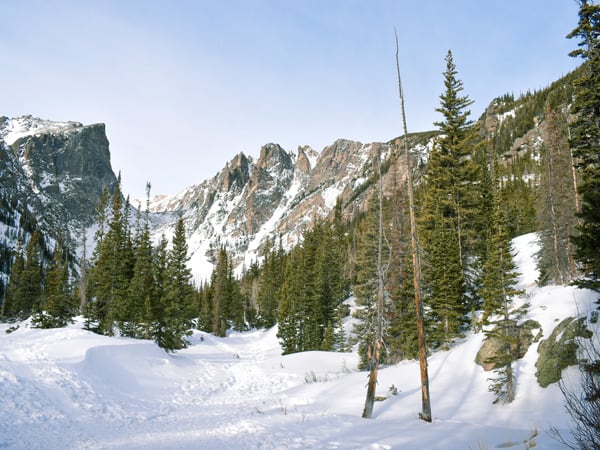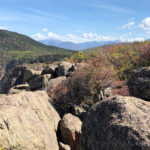
While Rocky Mountain National Park is much more popular in the summer, winter can be a magical time as well. The number of visitors in the summer months increases tenfold compared to winter months, so you won’t be fighting traffic if you travel in the off-season, and much of the park will be covered in a picturesque blanket of white snow.
If you’re considering a trip, here’s what you need to know:
1. You won’t be able to access the entire park.
A portion of Trail Ridge Road that connects the Estes Park side and the Grand Lake side of Rocky Mountain National Park is closed (typically from October through the end of May). This means you’ll most likely be staying on one side of the park or the other, as the alternate route would take at least three hours each direction.
Check the National Park Service (NPS) website for estimated road opening dates if you’d like to see the whole park.
2. Some of the Visitors’ Centers will be closed.
Be sure to check the NPS website for the most up-to-date information. Generally, the Beaver Meadows and Fall River centers are open year-round (excluding some major holidays). The Kawuneeche center is open Wednesday through Sunday at reduced hours in the winter and spring.
The Alpine Visitor Center, Moraine Park Discovery Center, Sheep Lakes Information Station, and Holzwarth Historic Site (interior) are only open in the summer and early fall.
All entrance stations/pay stations operate year-round. The park access fee in 2021 is $25 for single-day entry (per vehicle) and $35 for seven consecutive days.
3. You won’t have the entire park to yourself.
Rocky Mountain National Park may be less busy than when the weather is warmer, but you won’t be totally secluded. If you have a must-do hike in mind (especially if the trailhead begins off of Bear Lake Road, like Sprague Lake or Dream Lake), you still need to arrive to the trailhead early to get a parking spot.
4. The entire park might not be covered in snow.
This might be a positive or a negative depending on what you’re looking for! I was surprised when I visited in January and there was essentially no snow in many parts of the park (on the Estes Park side in particular).
Snow disappears more quickly than you’d think. At lower elevations, it melts as temperatures rise above freezing. At higher elevations, fresh powder can quickly blow away in high winds. Also, because the air is so dry, snow can evaporate without ever melting through a process called sublimation.
If you’re expecting every corner to look like a winter wonderland, you might be disappointed.
5. There aren’t ski resorts around Estes Park.
I am used to mountain towns that are close to ski resorts, allowing access to tons of different activities. You won’t find this on the Estes Park side, but there is still plenty to keep you busy! Check out this post for itinerary ideas.
However, on the Grand Lake side, you’ll be 45 minutes from Granby Ranch and an hour from Winter Park. You can have your fill of resort activities like skiing, snowboarding, tubing, and even a scenic lift ride if you’re not up for mountain sports.
6. You may need a vehicle with four-wheel drive or tire chains.
If you’re staying only on the Estes Park side and the weather has been warm lately, you might be okay with a smaller vehicle. The cities and the NPS do work hard to maintain the roads; however, if you’re planning a trip in advance, don’t take the chance of getting stuck in the snow (or worse, sliding on the ice and potentially causing an accident).
On the Grand Lake side, you’ll definitely need a properly-equipped vehicle. The drive will take you through Berthoud Pass, which is part of the Continental Divide – at over 11,000 feet in elevation, you’re almost certain to encounter icy conditions.
In fact, there are regulations in place requiring drivers on certain roads to have four-wheel drive or chains from September 1 through May 31. You’ll get a hefty fine if you ignore these requirements and end up in an accident. If you are unsure, ask your rental car agency or your accommodation about what to expect.
7. Consider renting microspikes or snowshoes.
If you plan to do any walking or winter hiking, you’ll want waterproof boots at a minimum. Hiking boots will work fine if you plan to stay on the heavily-trafficked trails, but attaching a pair of microspikes (chains with small spikes) onto your footwear will help prevent you from slipping on the slick snow.
These are very easy to wear, as they slip on right over your boots, and they’re available to rent from many winter sports equipment rental shops.
If you plan to traverse deeper snow or less trafficked areas, you’ll want to consider snowshoes or even cross-country skis, as microspikes will not help you stay atop of soft powder.
To rent winter gear, head to Estes Park Mountain Shop on the east side and Epic Mountain Sports or Icebox Mountain Sports (in Winter Park) on the west side. If you’re looking for a shop closer to the west entrance of the park, check out Granby Ranch (but you’ll pay higher prices than the shops in Winter Park).
Some lodges, like Lupine Village in Grand Lake, have equipment available to check out for free. Be sure to ask your accommodation before you spend money on a rental.
8. There aren’t any restaurants inside the park.
While there are plenty of restaurants in Estes Park and Grand Lake, you won’t be able to purchase food in the national park. Stop by the grocery store and stock up on snacks, drinks, and picnic items. Make sandwiches to eat in the car as you drive.
There’s a Safeway about 15 minutes from the entrances on the Estes Park side. On the Grand Lake side, stop at the City Market in Granby on your way up, or there’s a smaller grocery store, Mountain Market, in Grand Lake.
9. Dress in layers.
As with all winter adventures, be prepared for encountering any type of weather. Read this post from Barefoot Theory for more about how to dress appropriately to keep warm. You don’t necessarily need expensive items, just make sure you wear layers along with a scarf, hat, and gloves (preferably waterproof).
Hand warmers, such as HotHands, are also a must for me. I keep them in my pockets or inside my mittens if my fingers start to feel very cold, and they’re especially helpful if my mittens have gotten wet in the snow. You can find them at most large chain stores or on Amazon.
Ready to plan your trip? Check out my itinerary for a weekend stay in Estes Park to explore this beautiful area of Colorado!
You Might Also Like...
-
How to Spend a Day at Black Canyon of the Gunnison National Park
What a hidden gem! I had never even heard of this park until I drove past it on my way to Telluride. Five hours southwest of Denver and about an…
-
How to Spend a Day at Black Canyon of the Gunnison National Park
What a hidden gem! I had never even heard of this park until I drove past it on my way to Telluride. Five hours southwest of Denver and about an…
-
How to Spend a Day at Black Canyon of the Gunnison National Park
What a hidden gem! I had never even heard of this park until I drove past it on my way to Telluride. Five hours southwest of Denver and about an…

